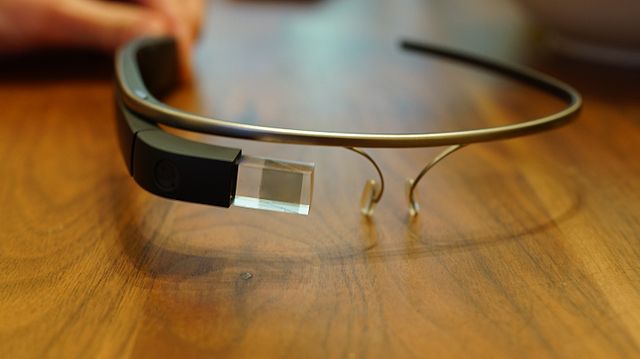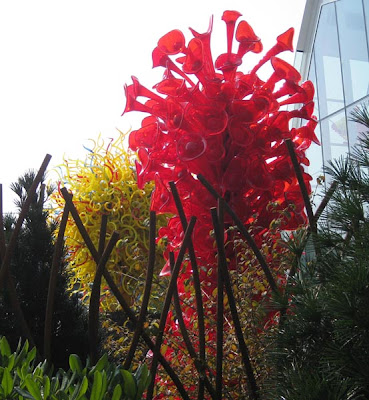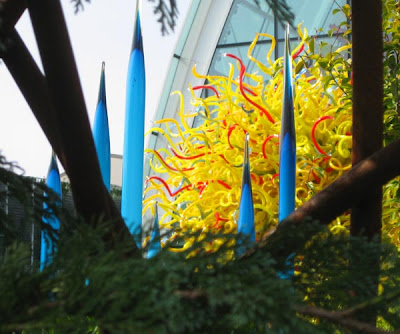By Juliana Nykolaiszyn
It was late in the day when a nondescript package arrived at my office. After carefully opening the box and lifting off the lid, there it was: Google Glass. And yes, it was awesome. Initially, the technology geek in me was overjoyed, but the oral historian soon took over as I raced through potential uses for this wearable technology in my daily work.

Google’s augmented reality head mounted display as glass form. Photo by Ted Eytan. CC BY-SA 2.0 via taedc Flickr.
I have found Google Glass provides unique challenges to and opportunities for conducting oral history, from interviewing to access. Worn like a pair of glasses, Google Glass allows users to take a photo, record video, get directions, send messages, search the Internet, make phone calls, and more with a simple voice command, “Ok Glass.” Google made this innovative piece of tech available to a limited audience of beta testers or “Glass Explorers” in 2013. Google Glass is easier to obtain today, cost remaining the most prohibitive factor. A lower cost consumer model is in the works, and is expected to be released later in 2014. This may dispel the social stigma that has developed around the wearable technology.
Over the last few months, I have put Google Glass through its paces with oral history in mind. I’ve learned that in an interview setting, Glass can be awkward for the narrator and the interviewer, and thus negatively impact the overall exchange. In fact, I was downright distracted while attempting to record with the unit, even in brief stretches. Maybe it is because I am not accustomed to wearing glasses, but there were other factors at play as well. First, you cannot zoom in while recording video, which limits framing the shot. And though Google Glass captures video in 720p, the battery limits recording time to approximately 43 minutes. Similarly, there is only 12 GB of usable memory. Another major downfall of Google Glass is the built-in microphone. The mic can easily and clearly record the person wearing the unit, but struggles to pick up other voices, such as narrators stationed at a comfortable distance. Furthermore, the mic is not omnidirectional, lessening the overall quality of recordings.
Click here to view the embedded video.
Here is an example of conducting an interview with Google Glass.
Credit: Oklahoma Oral History Research Program
Despite the technical shortcomings, I still see promise for using this type of wearable technology to gather oral histories. Google Glass can be used in instruction training tool. It provides a unique perspective for analysis, helping interviewers understand their connection to narrators, and to monitor head movements or gaze during a recording session. Another potential area of growth is access. Exhibits utilizing Google Glass are starting to emerge in several cultural institutions, including the New Museum in New York and the UK’s Manchester Art Gallery. Third-party applications are also being developed, which will only add to one’s ability to use Glass to enhance public displays. Finally, Glass may provide oral historians the ability to share interviews across geographic boundaries. Interviews can be live streamed via Google Hangouts, allowing for real-time access and interaction, perfect for connecting groups inside or outside the classroom.
At the end of the day, oral history is complimented by technology. While we have seen shifts and changes through the years, technology is still very important to recording, preserving, and accessing oral history. Google Glass may not be as robust as it could be for the purposes of documenting and preserving the history around us, but I am betting this type of wearable technology will move past these shortcomings sooner rather than later. As for its role in oral history, my initial experience suggests only time will tell how we will use it.
Juliana Nykolaiszyn is an Associate Professor/Librarian with the Oklahoma Oral History Research Program at the Oklahoma State University Library. She serves as an interviewer on several oral history projects, including the Inductees of the Oklahoma Women’s Hall of Fame, Oklahoma Centennial Farm Families, O-STATE Stories and the Spotlighting Oklahoma series. In addition to interviewing, Juliana is involved in making materials available online, primarily through CONTENTdm and other web-based efforts.
The Oral History Review, published by the Oral History Association, is the U.S. journal of record for the theory and practice of oral history. Its primary mission is to explore the nature and significance of oral history and advance understanding of the field among scholars, educators, practitioners, and the general public. Follow them on Twitter at @oralhistreview, like them on Facebook, add them to your circles on Google Plus, follow them on Tumblr, listen to them on Soundcloud, or follow their latest OUPblog posts via email or RSS to preview, learn, connect, discover, and study oral history.
Subscribe to the OUPblog via email or RSS.
Subscribe to only history articles on the OUPblog via email or RSS.
The post Oral history through Google Glass appeared first on OUPblog.

Lovely harmonies from the High Kings -
The gardens actually do look amazing - although they are pretty well fenced off so you can only get a few glimpses -
(Our feet were already museumed-out from the King Tut exhibit, or I would have been tempted to meander through this one as well - )
As it was, we only browsed (the rather awesome) gift shop -
Nobody does glass installations like Dale Chihuly. Can't wait to see lit up at night!

iTunes users can subscribe to this podcast 
Glass is an example of a word that has shattered into lots of meanings we currently recognize but also with many earlier and forgotten etymological branches.
In English the word shows up well over 1100 years ago in the works attributed to King Alfred the Great.
Then, as now, the word meant the substance glass.
Since people make lots of useful things out of glass these too began adopt the word as their name:
- windows,
- drinking vessels,
- bottles,
- hourglasses,
- telescopes,
- spectacles,
- mirrors,
- barometers,
- magnifying glasses, and
- microscopes
have all at some time in the last 600 years or so been called a glass.
 Today, apart from the material itself, spectacles and drinking vessels are the things that come to mind when someone refers to their glasses without which they can’t find their glass.
Today, apart from the material itself, spectacles and drinking vessels are the things that come to mind when someone refers to their glasses without which they can’t find their glass.
The word glass arrived with the oldest of Old English, because the manufacture of glass is one of the oldest of technologies.
According to John Ayto’s book Word Origins, glass manufacture historically produced colored glass, not clear glass, and so ghel, the Indo-European ancestor of glass, was actually a color word that also gave Greek a word meaning “green” and English the word yellow.
The American Heritage Dictionary assigns this same Indo-European root ghel the meaning “to shine,” and so associates the root with the word gold.
Glass is sometimes said to be a super-cooled fluid as opposed to a solid.
The reason people say this is that unlike many minerals glass isn’t formed into crystals but made up of its constituent molecules all jumbled together at random as they would be in a liquid.
This is what makes glass so useful because unlike H2O which turns from ice to water all in a rush, glass just becomes oozier and oozier as it warms up and thus can be formed into all the useful objects that people want to refer to as a glass.
This too is why the windows in ancient buildings are made up of panes that are thin at the top and thicker at the bottom. Over the centuries they too have oozed; just very, very slowly.
Five days a week Charles Hodgson produces
Podictionary – the podcast for word lovers, Thursday episodes here at OUPblog. He’s also the author of several books including his latest
History of Wine Words – An Intoxicating Dictionary of Etymology from the Vineyard, Glass, and Bottle.

A CONVERSATION WITH DANIEL VALDEZ

A founding member of
Teatro Campesino. Henry Reyna in the movie
Zoot Suit, for which he also wrote the music.
Producer
of
La Bamba. Songwriter:
Primavera; Brown-Eyed Children of the Sun. Linda Ronstadt and Canciones de Mi Padre. Playwright. Actor. Musician.
The list of Daniel Valdez’s accomplishments reads like a dictionary of Chicano Culture. He's done it all: Movement theater to Hollywood productions; sentimental love ballads to re-imagining Mexican mariachi classics; edgy drama to slapstick comedy. Valdez has provided more than thirty years of political entertainment. In many ways he is an artistic conscience for the Latino generation that came of age at the beginning of the farm worker union organizing movement in the mid-sixties, matured through the antiwar struggles, and that continues to push a progressive agenda.
His latest endeavor is Ollin – an art performance piece that had its world debut in Denver on February 21 at El Centro Su Teatro (last show is March 29.) I had the chance to speak with Daniel for a few minutes during his hectic schedule while he was in town for the premiere. It was supposed to be an interview, but anyone who has ever talked with Daniel knows that the Q&A format isn’t big enough for what happens when Daniel gets going. Here is my impression of a few of the things he touched on when I began the conversation with the simple query, “What’s Ollin about?”
Ollin refers to the Fifth Sun – we are still in the time of the Fifth Sun of the Mayan prophecies. Ollin actually means “movement.” The piece is about the Conquest of Mexico by the Spaniards. Valdez sees that episode as a “cosmic clash” – he referred to a “big bang” theory of history between the Spanish and Indio.

The story is told through the perspective of Cortez, and the audience learns his ambitions and his struggles. His story is contrasted with that of Moctezuma, the Indio King. Moctezuma was aware of the prophecies and he looked at the conquest as fate; it had been predicted by Quetzalcoatl. The piece also gives us Malinche, forced to be in the middle, she has the third point of view. Valdez suggests that “she saved lives” by her involvement and influence. She was the bridge between the other two, the symbolic mother of the first mestizo.
The narrative starts 800 years before the conquest, with Quetzalcoatl. Ironically, Cortez arrived on the day that Quetzalcoatl had predicted his own return. Many Indios thought Cortez was Quetzalcoatl because of the prediction, but only 300 Spaniards conquered 500,000 natives, so something else was going on – “destiny.” Valdez imagines Moctezuma as believing that the conquest was destiny, fate, inevitable. And the numerous tribes that were unhappy with the Aztecs – the smoldering dissension - added to the clash. There was no way to avoid what eventually happened.

The piece started as a radio show back in the 1980s for National Public Radio. Valdez wanted to bring “light and understanding” to the conquest. He wrote what he thought would be a 2-3 page poem but that ended up being 22-23 pages, the beginning of the narrative for the current piece. He realized then that he needed to expand his vision for the poem.
Valdez told me that Ollin is more of an art performance piece than a play. It incorporates dance, music, and spoken word, and is presented in a poetic format. He calculates that eighty percent of the piece is music, with several pre-Colombian dance episodes. The play is primarily in English with some Spanish and Nahuatl.
Kids can understand the history. Valdez's intent is to bring “clarity to the conquest." Teachers at an early performance told Daniel they liked it and that they thought it would be excellent for children.
This is Daniel Valdez's third collaboration with Tony Garcia, Artistic Executive Director of El Centro Su Teatro, and the Su Teatro company.
As for future plans, Valdez said that he would love to take Ollin on the road, if the opportunity presents itself. Meanwhile, here in Colorado, he is scheduled to get involved with a project to produce an oratorio about the history of Pueblo, Colorado, a unique community with a long and proud Chicano working-class presence.
At the end, after he finally took a breath, he encouraged people to bring their kids to the performance; he insisted that the piece is family oriented; that it is a fun play; and that it can bring generations together. It should be "shared by a family."
He concluded, with a laugh, “Ollin is a poor man’s version of Cirque du Soleil.”
Ollin
Written and Directed by Daniel Valdez
February 21 – March 29, 2008
Major players: Bobby LeFebre, Jesse Ogas, Felicia Gallegos Pettis, Valarie Castillo, Lara Gallegos
Otros:
Joaquin Liebert, David Carrasco, Anthony Saiz, Jose Guerrero, Natalia Romo Musicos:
Tony Silva (Musical Director), Angel Mendez Soto, Robert Gale, Rogelio Ransoli
El Centro Su Teatro
4725 High Street
Denver
303-296-0219
OTHER THEATER NOTES
LydiaWritten by
Octavio SolisDirected by
Juliette CarriloThe Ricketson Theater, Denver Center for the Performing Arts
January 18 - March 1
 This superb play
This superb play highlights a mini Golden Age of Latino Theater in Denver. Since the beginning of the year, Denver audiences have been treated to
Las Chicas Del 3.5" Floppies (
Luis Enrique Gutiérrez Ortiz Monasterio); a special reading of
Sunsets and Margaritas by
José Cruz González;
Ollin (Daniel Valdez);
José Mercado directing
Comedy of Errors; and the world premiere of
Lydia. We could get spoiled and expect this all the time. Which will happen if the audience is there. Support these events, gente.
Lydia has an excellent cast:
Carlo Albán, Christian Barillas, Stephanie Beatriz, Ricardo Gutierrez, Catalina Maynard, René Millán, Onahoua Rodriguez - not a lightweight in the bunch, all with extensive experience although several are making their Denver Center debut. Under the precise direction of Carrilo, Soliz's story of family warfare rips the audience and movingly exposes the characters' fears, ambitions, and mistakes. The program summarizes the story this way:
"Ceci Flores introduces her family: her father Claudio, a Mexican immigrant working as a cook in El Paso; her mother Rosa, whose dream brought her family to the U.S.; her tough-acting elder brother René; and her more serious younger brother Misha. Ceci herself has brain damage, and although the audience understands her, she cannot communicate with her family or anyone else -- until the new maid Lydia arrives, fresh from Mexico. Ceci's cousin Alvaro has recently returned from Vietnam; his appearance, along with Lydia's knack for interpreting Ceci, dredges up secrets from the past and reveals the desires that could bring the family together or tear them apart."
This is heavy, as they used to say. It's encouraging to see such a broad range of themes and formats in these plays. The courage displayed by the writers as they confront controversial and sensitive topics should inspire us all. The pen continues to be a powerful force to beat back society's demons.
Finally - Feliz Cumpleaños to Rudy Ch. Garcia. This is a big one, dude. Time to drag out all the bromides about age. Here's one to get you started; it's schmaltz but I think you respect the source:It is not true that people stop pursuing dreams because they grow old, they grow old because they stop pursuing dreams.Gabriel García MárquezLater.












 Today, apart from the material itself, spectacles and drinking vessels are the things that come to mind when someone refers to their glasses without which they can’t find their glass.
Today, apart from the material itself, spectacles and drinking vessels are the things that come to mind when someone refers to their glasses without which they can’t find their glass.



Majestic knitting needles! Going to have to check this out.
Cool images...
Best wishes from Buenos Aires...
http://www.alexiev.com.ar/
Proyectos - Illustrations
Alexiev Store - venta de originales
@alexievg en twitter